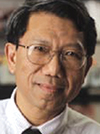Out-of-This-World Research on Osteoporosis
Pitt Professor Rocky Tuan is contributing to research that will be conducted onboard the International Space Station (ISS). He recently received a grant from the Center for the Advancement of Science in Space (CASIS) for his work on a 3-D microphysiological system to evaluate the accelerated aging and degeneration of bones that occur in space.
 “Studying such rapid progression offers great advantages to developing treatments for osteoporosis faster and more effectively, in ways that are not possible on Earth,” said Tuan, who is the Arthur J. Rooney, Sr. Chair Professor in Sports Medicine in the School of Medicine’s Department of Orthopaedic Surgery. “Our research will benefit not only the health of astronauts for long stays in space on the ISS or a future journey to Mars, but also will help people on Earth, providing capabilities for the screening of drug therapies, enhancing personalized medicine, and developing bioreactor technologies for tissue engineering.”
“Studying such rapid progression offers great advantages to developing treatments for osteoporosis faster and more effectively, in ways that are not possible on Earth,” said Tuan, who is the Arthur J. Rooney, Sr. Chair Professor in Sports Medicine in the School of Medicine’s Department of Orthopaedic Surgery. “Our research will benefit not only the health of astronauts for long stays in space on the ISS or a future journey to Mars, but also will help people on Earth, providing capabilities for the screening of drug therapies, enhancing personalized medicine, and developing bioreactor technologies for tissue engineering.”
The award is part of the 3D Microphysiological Systems for Organs-On-Chips Grand Challenge by CASIS, which was chosen by NASA in 2011 to be the sole manager of the ISS U.S. National Laboratory. The June announcement was made at the White House Organ Summit.
Tuan is director of the Cellular and Molecular Engineering Lab and a Distinguished Professor in Orthopaedic Surgery. He is internationally known for his research in stem cell biology, musculoskeletal tissue engineering, regenerative medicine, and for his innovative leadership role in biomedical education. He also is associate director of Pitt’s McGowan Institute for Regenerative Medicine and director of the Center for Military Medicine Research.
With Tuan’s leadership, Pitt’s Center for Cellular and Molecular Engineering focuses on the science of treating injuries and diseases of the musculoskeletal system, using nanotechnology and mechanobiological principles in combination with bioreactor and biomaterials technologies, including 3-D printing, for functional skeletal tissue engineering and regeneration.
Other Stories From This Issue
On the Freedom Road

Follow a group of Pitt students on the Returning to the Roots of Civil Rights bus tour, a nine-day, 2,300-mile journey crisscrossing five states.
Day 1: The Awakening
Day 2: Deep Impressions
Day 3: Music, Montgomery, and More
Day 4: Looking Back, Looking Forward
Day 5: Learning to Remember
Day 6: The Mountaintop
Day 7: Slavery and Beyond
Day 8: Lessons to Bring Home
Day 9: Final Lessons

